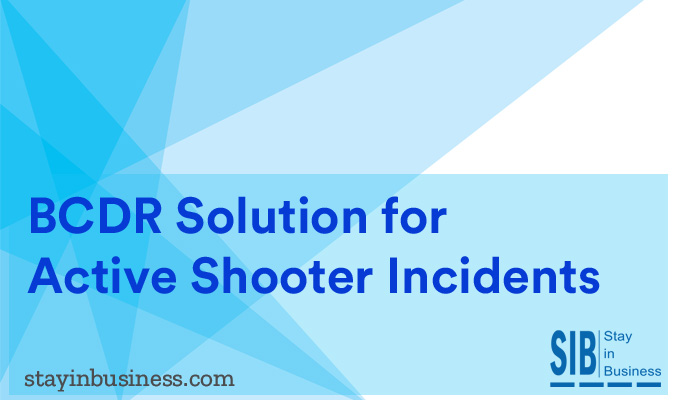
Organizations tend to prepare for disasters such as fires, cyclones, earthquakes, system shutdowns and power outages. However, in recent years, planning for active shooter incidents is becoming an increasingly prominent feature of any Business Continuity and Disaster Recovery solution.
Active shooter incidents are unusual occurrences to deal with, especially from a business continuity and disaster recovery perspective which is primarily concerned with keeping processes operational during and after a disruption. Active shooter incidents have the potential to jeopardize the lives and safety people. Response measures involve dealing with people with firearms who are intent on acts of violence.
Needless to say, active shooter incidents and organizational BCDR plans have very little in common and are mutually contrasting entities.
Emergency teams are more predisposed to dealing with environmental hazards, sociopolitical events, economic trends and developments. However, the rise in frequency with which active shooter incidents are catching institutions across the United States unaware has obliged emergency teams to take these occurrences into consideration. Active shooter incidents also include the use of explosives and motor vehicles in acts of violence.
Some of the commercial reasons for businesses to include an active shooter module in the BCDR plan have been listed below:
- Active shooter incidents threaten the lives and safety of people. In the case of fatalities, such incidents can cause irreparable damage to a company’s brand and public perception. Leadership teams would be liable to give valid reasons for not taking precautionary measures to avert the adverse impacts of the incident. It would also give customers and stakeholders a very negative impression about the organization’s commitment to operational resiliency which directly affects its commercial deliverables.
- If things go wrong, the press and media rarely take a charitable view of the situation. The lack of a comprehensive and foolproof plan to counter active shooter incidents is reason enough to publicly criticize the organization’s business ethos. The negative publicity could go viral especially on social media where most businesses these days have a strong presence.
- Fatalities and the impact on health and safety can make the organization liable to face charges and lawsuits. Such legal proceedings tend to be long drawn affairs and usually span over extended periods of time. They also cost the company a lot of money.
- Apart from difficulties in attracting new customers, organizations might also encounter trouble recruiting new staff members if the management’s commitment to ensuring the health and safety of its employees is questionable. Attrition rates are likely to climb. The repercussions of an active shooter incident vary from company to company and emergency teams must factor the organization’s specific business conditions while designing its BCDR solution.
Segregating an Active Shooter Module
Besides the already stated impact on life, health and safety, active shooter incidents are also important from an entrepreneurial perspective. Tabletop exercises are usually a good place to start as the factors that influence an active shooter incident are many and varied. Findings from the tabletop exercise should be incorporated into the response plan.
Apart from public areas such as places of worship and recreational zones, active shooter incidents also occur in institutions such as schools and colleges. Offices and other production facilities are also frequently targeted. Many of these crimes are perpetrated by spiteful employees seeking vengeance.
Any active shooter module can be broadly broken down into the following segments:
- Detecting an active shooter on the premises
- Confining and isolating the location
- Minimizing the shooter’s target area
- Notifying the police, authorities and other official agencies
- Informing staff and the public
- Moving individuals into places of shelter
- Deploying the recovery plan
Conventional measures won’t do while recovering from an active shooter incident. The organization’s specific business environment needs to be taken into consideration while designing a plan. Below are some generic response measures.
Escape
Emergency teams must prioritize evacuating the location.
- Create an exit route
- Practice evacuation regularly through drills
- Time the exercise
- Don’t waste time gathering belongings
- Evacuate as a group
- Avoid areas and zones within the active shooter’s immediate reach
- Don’t hide your hands
- Seek assistance from police officials for suggestions and improvements
- Avoid trying to move injured people
- Call 911 once out of danger
Cover
If leaving the premises is too risky, emergency teams must have a safe and secure place ready where people can hide. This shelter should be:
- Out of Sight
- Bullet Proof
- Nonrestrictive in terms of movement
Ensure that the active shooter can’t break into the place of shelter.
While inside,
- Lock the entrance and secure it with furniture
- Turn off cell phones, gadgets and all electronics appliances
- Take Cover behind cabinets, bureaus or heavy furniture
- Stay Calm
If it is not possible to escape or hide, call 911 and quickly share the active shooter’s location with the police. If you can’t talk, just call inconspicuously and leave the line open.
Confront
When all the earlier options have been ruled out, individuals have no other option but to confront the active shooter by:
- Attacking him or her aggressively
- Hurling items
- Confusing the active shooter by screaming or panicking
- Ganging up on the active shooter if many individuals are present
See for yourself how the application works
Witness our cloud based platform’s security capabilities in action
Play around with the software and explore its features
Compare and choose a solution that’s relevant to your organization
Consult our experts and decide on a pricing mechanism
Disasters
[carousel id=’1780′ items=’4′ items_desktop=’3′ margin_right=’5′ navigation=’false’] [item img_link=”https://www.stayinbusiness.com/wp-content/uploads/2016/02/Chemical-Spills-Discharges.jpg” href=”https://www.stayinbusiness.com/resource/disaster-recovery/chemical-spills-and-discharges/”][item img_link=”https://www.stayinbusiness.com/wp-content/uploads/2016/02/Riots-Public-Disturbances.jpg” href=”https://www.stayinbusiness.com/resource/disaster-recovery/riots-and-public-disturbances/”][item img_link=”https://www.stayinbusiness.com/wp-content/uploads/2016/02/Terrorism.jpg” href=”https://www.stayinbusiness.com/resource/disaster-recovery/terrorism/”] [item img_link=”https://www.stayinbusiness.com/wp-content/uploads/2016/02/worst-product-recall.jpg” href=”https://www.stayinbusiness.com/resource/disaster-recovery/product-recall/”] [/carousel]
